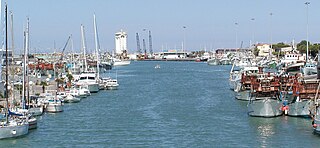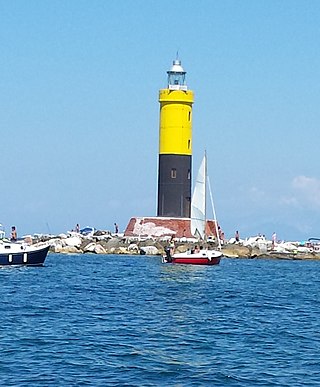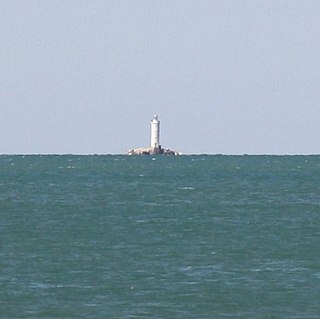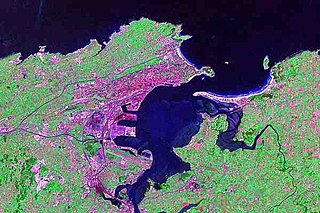
Livorno is a port city on the Ligurian Sea on the western coast of the Tuscany region, Italy. It is the capital of the Province of Livorno, having a population of 158,493 residents in December 2017. It is traditionally known in English as Leghorn.

Civitavecchia is a city and major sea port on the Tyrrhenian Sea 60 kilometres west-northwest of Rome. Its legal status is a comune (municipality) of Rome, Lazio.

Meloria is a rocky skerry, surrounded by a shoal, off the Tuscan coast, in the Ligurian sea, 6.1 kilometres (3.8 mi) north-west of Livorno.

The Port of Genoa is one of the most important seaports in Italy. With a trade volume of 51.6 million tonnes, it is the busiest port of Italy after the port of Trieste by cargo tonnage.

The port of Pescara is an Italian port on the Adriatic Sea at the mouth of the River The Pescara in the city of Pescara.

Port of Civitavecchia, also known as "Port of Rome", or Civitavecchia Port of Rome, is the seaport of Civitavecchia, Metropolitan City of Rome, Italy. It is an important hub for the maritime transport in Italy, for goods and passengers. The Rome Cruise Terminal is part of the port. Part of the "Motorways of the Sea", it is linked to several Mediterranean ports and represents one of the main links between the Italian mainland and Sardinia.

The Livorno Lighthouse is an active lighthouse located at the south entrance of the Port of Livorno in Tuscany on the Ligurian Sea.

Capo Carbonara Lighthouse is a light situated at the extremity of the granite promontory of Capo Carbonara, in the comune of Villasimius, on the eastern side of Gulf of Cagliari inside the Marine protected area of Capo Carbonara.

The Old Fortress of Livorno is a castle in Livorno, Italy. The Old Fortress is a successor building to a medieval fort built by the city of Pisa in the location of an older keep built by Countess Matilda of Tuscany in the 11th century. The 11th century tower was incorporated inside the fort built by the Pisans. The castle has been described as a "symbol of Medicean Livorno". The fort is located at the Medicean Darsena, or old dock of the port of Livorno, built by the Medici family. The ceremony proclaiming Livorno a city took place inside the fortress on 19 March 1606.
The following is a timeline of the history of the city of Livorno in the Tuscany region of Italy.

Meloria south end Lighthouse is an active lighthouse located in the Ligurian Sea, 3 nautical miles west of the south entrance of the Port of Livorno, in the southern part of the Meloria shoal.

Meloria north end Lighthouse is an active lighthouse located in the Ligurian Sea, 7.5 nautical miles north of Meloria south end Lighthouse and 7.5 nautical miles north west of Livorno, in the northern part of the Meloria shoal.

Ischia Porto Lighthouse is an active lighthouse located on the northern end of the western mole of the Port of Ischia, Campania on the Tyrrhenian Sea.

Molo San Vincenzo Lighthouse is an active lighthouse located at the end of the western side to the entrance of the Port of Naples, Campania on the Tyrrhenian Sea.

Camogli Molo Esterno Lighthouse is an active lighthouse located at the end of the external breakwater of the harbour of Camogli, Liguria on the Ligurian Sea.

Civitanova Marche Lighthouse is an active lighthouse located in front of the Port of Civitanova Marche, Marche on the Adriatic Sea.

Isolotto della Maddalena Lighthouse is an active lighthouse located on a small islet, 84 metres (276 ft) long, placed 800 metres (2,600 ft) north of the south mole of the Port of Alghero on the Sea of Sardinia.

Viareggio Diga Foranea Lighthouse is an active lighthouse, located at halfway the breakwater of the dock of Viareggio on the Ligurian Sea.

The Port of Santander, Cantabria (Spain), is located in the Cantabrian Sea, specifically in the Bay of Santander, in the municipalities of Santander, Camargo and Marina de Cudeyo. It is managed by the Port Authority of Santander, whose current president is Francisco Martín Gallego, under the public entity Ports of the State and in turn administered by the Ministry of Transport, Mobility and Urban Agenda. It belongs to the maritime province of Santander (ST). Santander District (ST-4).





























